Review Sigma 24105mm F4 Dg Os Hsm Art Lens for Nikon
Sigma 24-105mm f/iv.0 DG OS HSM Art Lens Review

Your general purpose lens selection short listing simply got one lens longer. The Sigma 24-105mm f/iv.0 DG Os HSM Art Lens, featuring nifty image quality, splendid build quality and optical stabilization, definitely deserves your consideration. This lens is a pleasure to apply, it looks great and the results from it look even better.
Sigma makes a wide variety of lenses, just until at present, has been missing a stabilized full-frame format general purpose lens. As such, the 24-105mm f/four Bone lens addition to the Sigma lineup is completely welcomed by me.
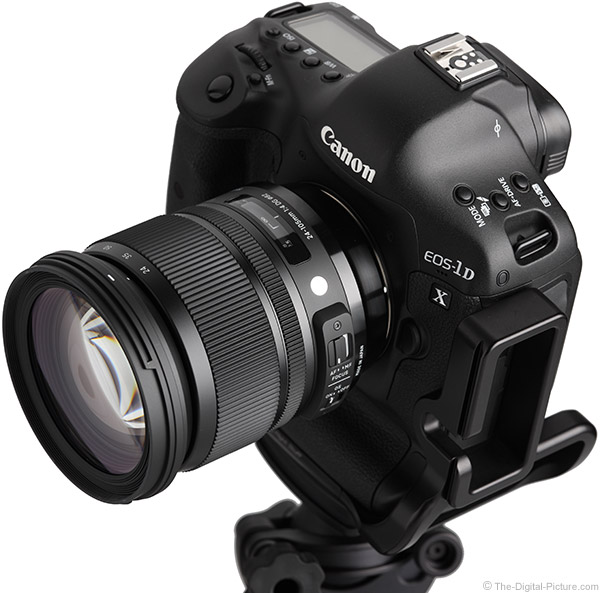
Focal Length
Past (my) definition, a general purpose lens is one that volition cover a very wide range of typical photography subjects. This lens type is usually the first I tell people to get with their commencement DSLR camera. The focal length range is the biggest cistron in my considering a lens to fall in the general purpose lens category. For those of you using a full frame format sensor, the 24-105mm focal length range found in this lens will supersede my recommended full general purpose lens focal length range by a very comfortable margin on the long cease.
Here is a pair of examples showing what this focal length range looks like:

The get-go set of examples utilizes the printed-on-the-lens focal lengths. For the 2nd set, I attempted to hit 28mm (I estimated slightly long) and omitted 80mm every bit it is relatively close to 70mm. The 24-70mm focal length range is a very mutual one. The comparing above shows the specific advantage of having upward to 105mm available.
Those on the APS-C (1.6x FOVCF) format will see an angle of view equivalent to 38.four-168mm on a full frame DSLR. This range is somewhat lacking from a broad angle perspective, but information technology has a very attractive long end. If your focal length needs gravitate toward the long finish, a 24-105mm lens will be very useful to you.
As I said, by definition, a general purpose lens has a very wide range of uses. One of my favorite such uses is for landscape photography. Information technology is not difficult to compose excellent 24mm landscape images that evoke a sense of presence and at 105mm, it is even easier to find attractive mural compositions.
People are of grade hugely-pop general purpose lens subjects, and with the focal lengths upwards to 105mm included, this lens allows swell perspective for even relatively tightly framed portraits. Zoom out to 24mm and capture the entire group and/or the environment your subject is in.

The number of other uses for this lens is every bit vast every bit your imagination. Products, cars/trucks/boats/bikes, art, cities, beaches, mountains, sports (best-suited for outdoor sports), parties, pets and much more.

Aperture
In the Sigma printing release, "Amir-Hamzeh added that this new lens combines the largest possible fixed aperture to zoom ratio that volition maintain optimal integrity ..." Interesting is that, until at present, the Sigma line has been completely void of stock-still f/iv max discontinuity zoom lenses. An f/4 aperture is large, but f/4 allows ane/two as much light to reach the sensor (one end darker) as the f/2.8 zooms allow. But you volition not find any 24-to-something zoom lenses reaching longer than 70mm with an f/2.8 discontinuity available.
If shooting action in low calorie-free, I'm going to want one of the f/ii.viii variants that will allow me to use a shutter speed that is twice every bit fast. If shooting the night sky, I adopt f/2.viii (the earth is in action). Y'all of course need to determine if f/4 is wide enough for your needs.
I tin tell you that the paradigm quality from this lens is indeed, equally Amir-Hamzeh mentioned, "optimal" (much more to come). And peachy is that you lot have the max f/iv aperture available at all focal lengths. Dissimilar with a variable max aperture lens (an f/4-5.6 lens for example), yous can set a wide open aperture exposure that remains abiding over the full zoom range.
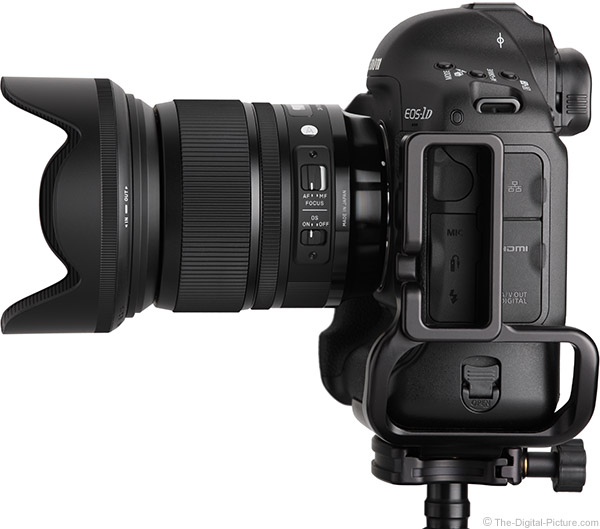
Optical Stabilization
Calculation greatly to the usefulness of this lens is optical stabilization. Os makes a huge difference when handholding this lens – delivering both sharper results at long shutter speeds and better-framed results thanks to a stabilized viewfinder.
Neat for video recording is that this Bone implementation is practically silent. Unique to this Bone implementation is that it is e'er active if the camera is powered on and the Bone switch is in the on position. And, I tin can hear the very faint OS noise fifty-fifty when OS is switched off. The departure in long exposure handheld image quality is vastly different with OS switched off, only the OS system is always running. I've never worried about battery drain when using stabilization (including with this lens), but I await that always-on stabilization uses some additional power.
At 24mm, my keeper charge per unit was well-nigh 100% with a .3 second exposure which is about 3 stops of aid for me. Nigh 60% of my images were precipitous at .four seconds, just my keeper charge per unit dropped rapidly beyond this exposure time.
At 105mm, I am getting mostly sharp results at 1/10 second with very gradual drop-off until just fewer than 50% of my images were precipitous at 1/five second. The keeper charge per unit and then plummets as the exposure elapsing increases. About 75% of images remain sharp at the approximately iv-stop of assistance 1/6 sec shutter speed.
These tests were done under platonic atmospheric condition. If you stitch a mount and take a shot under high wind weather, I can assure you that your .3 2nd exposure is non going to be precipitous. But IS is however going to exist beneficial in this state of affairs. Information technology is just that the benefit is shifted to shorter exposures.
Got ideal conditions? Shoot a lot of frames and you lot volition probable capture a sharp image (you probably merely need 1) at even longer exposures than I'thou talking about here. Below is a modestly-sharpened example of a .3 2d 105mm handheld capture.

I'm sure you concur that the difference between these two images is quite noticeable. Bone works. Unless the subject is moving. A shorter exposure is needed to stop subject motility.

Image Quality
Since a general purpose lens is frequently the virtually-used lens in the kit, and since the lens can be as important (or more of import) than the camera, it makes complete sense to become a high performance full general purpose lens model. And in the performance category, image quality is my most-cared-about characteristic. Great news is that the Sigma 24-105mm f/4.0 DG Bone HSM Art Lens performs extremely well and delivers particularly-abrupt images.
At 24mm through 35mm, this lens is very abrupt across the frame with some pocket-size full frame corner improvement showing at f/5.half-dozen. Using a 1 or 2 stop narrower-than-max aperture unremarkably delivers better paradigm sharpness, just the simply reason to stop this lens downwards to f/8 in the 24-35mm range is for increased depth of field or a longer exposure.
Though still quite abrupt at 50mm, I can see a very slight decline in wide open discontinuity image sharpness across the frame. Stopping downward to f/5.6 results in a very slightly sharper eye of the frame and a more than-noticeable improvement in corner sharpness. Sharpness at 70mm is very like to sharpness at 50mm, though the corners bear witness more clean-up continuing at f/eight. Still, image quality in the 50-70mm range is very good – merely bested slightly by the 24-35mm results.
At 105mm, wide open up aperture image sharpness takes a more noticeable pass up. The beyond-the-frame improvement at f/5.6 is stiff with corners showing slight improvement at f/8. While 105mm f/4 is usable, f/5.six will make you lot grin big.
Especially affecting 105mm epitome quality is relatively strong CA (Chromatic Aberration). Most zoom lenses exhibit some CA toward the border of their image circle at both extents of the focal length range and this is the case with the 24-105 Os. The overall corporeality of CA is not unusual, but CA at 105mm is slightly more noticeable than at 24mm. Here is a 105mm worst-case case:

CA is 1 of the most easily software-correctable lens flaws.
Using a lens with a full frame image circumvolve on an APS-C torso typically results in no noticeable light falloff in the frame corners even at wide open apertures and this is the case with the Sigma 24-105. Full frame camera owners volition, every bit usual, see light falloff when using this lens at wide apertures and still slightly at narrower apertures at the widest angle focal lengths. To be more than specific, at f/4, look nigh 3 stops of vignetting in the corners at 24mm and about ii.five stops at 105mm. The least amount of light falloff occurs at approximately 35mm where a just-visible i end of shading is seen in f/4 corners. At f/5.6, corner shading drops under 1 end over most of the focal length range except at 24mm where 1.2 stops of corner shading remains visible fifty-fifty at f/11.
Ii days prior to my initial lens loan render deadline, the skies finally cleared for a flare test. And I'm glad that I got this test opportunity because, while not flare-free, this lens performs very well with a brilliant lite source in the frame. The sunday in the case of this test.
You can count on a 24-something mm full frame zoom lens to deliver butt baloney on the wide end and pincushion distortion at the long cease. And the Sigma holds to this tradition. At 24mm, you are going to see moderately-potent barrel distortion – the center of the frame bulges outward. Zooming to a longer focal length changes the distortion to the pincushion blazon – with the sides pinching in toward the center. At 28mm, baloney is negligible, but moderately strong pincushion sets in presently afterward.
Following is a comparing of the 24-105's distortion at 24mm vs. 28mm. While distortion will not be recognizable in many scenes, a straight line nearly the border of the frame will make it articulate. Distortion also makes it hard to guess when the camera is perfectly level – something I am challenged to do without optical complications.

Zooming out slightly to 28mm makes a big difference in the squareness of the results. Distortion can of grade be corrected in software, but this correction is destructive at the pixel level. Again, this lens performs normally in regards to distortion.
The Sigma 24-105 Bone has a nine-rounded-blade aperture. As a generalization, the more than aperture blades the better, merely blade count is not a sole differentiator in defocused paradigm quality. More aperture blades tend to deliver more-rounded out-of-focus highlights with a stopped-downwards discontinuity (as exercise rounded blades). Meaning to some will exist that a lens' discontinuity has an odd or even blade count. An fifty-fifty blade count in a significantly stopped-down aperture will plow point calorie-free sources into stars with the aforementioned number of points as discontinuity blades. Odd blade count apertures will deliver twice equally many star points as blades – 18 points in this case. Hither is an example:

I'm not certain if I like odd or even blade counts better, but more important is the quality of the foreground and groundwork blur. And in this regard, the Sigma performs nicely. Specular highlights will show some brilliant borders and a couple of concentric circles inside, but they are nicely rounded fifty-fifty when stopped down and the circles centers are rather smoothen.

Beneath is a crop from near the superlative left corner of a Catechism EOS 5D Mark III-captured image. Those are stars and stars are supposed to exist circular. Nearly lenses do not evangelize round stars in the frame corners due to coma and the Sigma is over again normal in this regard.

Overall, I didn't find any below average Sigma 24-105mm f/4.0 DG Os HSM Art Lens image quality attributes, and the much-better-than-average paradigm sharpness this lens delivers is going to outcome a lot of these lenses sold.

Focusing
The Sigma 24-105mm f/four.0 DG OS HSM Art Lens features Sigma's HSM (Hypersonic Motor) focusing system. This particular HSM implementation is silent during utilize. Focus speed is reasonable, only not quite as fast every bit the Canon equivalent I am used to.
Especially of import is that AF accuracy has been skilful. In one-shot way, about of my images accept been properly focused. I idea that the focus speed would be an issue with activeness photography, only I was pleased with the proficient AI Servo AF functioning I encountered. This lens does not have the best-available AF system for action sports, merely unless the subject area was very close, my results were mostly in-focus. Overall AF performance is quite acceptable.
This lens is uniform with the Sigma USB Dock. The USB dock allows the lens' firmware to exist updated (bug fixes, compatibility updates, etc.) and allows precise focus calibration.
FTM (Full Time Manual) focusing is enabled and the lens does not change size with focusing (internal focusing). Some subject size change is noticed with focusing.
This lens is not parfocal. If you modify the focal length, refocus.
The manual focusing ring is very smooth with an platonic corporeality of rotational resistance. The xc° rotation is adequate for fine-focusing needs.
The Sigma's 17.seven" (450mm) MFD (Minimum Focusing Distance) delivers a 0.22x MM (Maximum Magnification). A .22x MM is a reasonable value and is in line with the other lenses in and near this class.
| Model | MFD | MM | |
| Canon EF 24-70mm f/iv 50 IS USM Lens | 7.9" | (200mm) | 0.70x |
| Catechism EF 24-105mm f/4 L IS USM Lens | 17.7" | (450mm) | 0.23x |
| Sigma 24-105mm f/4.0 DG OS HSM Art Lens | 17.vii" | (450mm) | 0.22x |
| Nikon 24-120mm f/4G AF-South VR Lens | 17.seven" | (450mm) | 0.24x |
| Nikon 24-70mm f/2.8G AF-Southward Lens | 14.iv" | (366mm) | 0.27x |
| Canon EF 24-70mm f/two.8 L II USM Lens | 15.0" | (380mm) | 0.21x |
| Sigma 24-70mm f/2.eight EX DG HSM Lens | 15.0" | (380mm) | 0.19x |
| Tamron 24-70mm f/ii.8 Di VC USD Lens | 15.0" | (380mm) | 0.20x |
No one is going to confuse 0.22x for a macro lens, but modestly-small subjects are fine targets for this magnification.

Build Quality & Features
I've had all of Sigma's Global Vision lenses available as of this review engagement and can tell y'all that I love the look and feel of all of these lenses. From the classy finish to the sharply ribbed safety rings that experience cracking to the smooth overall dimensions (except the raised switch area in this lens), these lenses have great pattern quality.

Similar all of the other lenses in its class, the Sigma 24-105 Bone extends when zooming to a longer focal length. The length of this extension is 1.86" (47.3mm). This lens features a double-extending lens barrel, but the extension remains solid even when fully extended. The zoom and focus rings are besides solid – and very shine. The switches are firm and snap into position – you are non likely to inadvertently modify one of these.

I know. You saw that the focus band is behind the zoom ring and idea to yourself, "Oh no, Bryan is going to complain nigh that." Well, I don't want to let you downwardly. I even so like rear-positioned zoom rings and front-positioned focus rings best. The camera and lens residual betoken is at the rear of this lens. That means that my thumb and first finger goes into the nicely rounded rear section of the lens and from that hold position, I attain forward to the zoom ring. And that means that the focus band is in the center, available for accidental rotation.
I want there to be no chance that I unintentionally rotate the focus ring after focus is caused. Nonetheless, this position is non such a big deal for this lens. Partly because this focus ring is rather narrow, partly because the zoom ring is raised and partly because the zoom ring rotation resistance is firm.
When I achieve forward, the large, raised zoom ring is very easy to find. This band is solid and very smooth with simply the right amount of resistance. No zoom extension lock switch is provided. Though I encountered some opposite gravity zooming when shooting with the lens extended and directed straight upward, I have not encountered any typical gravity zooming. Fifty-fifty when shaking the lens. I tin't predict what volition happen after a long menstruation of employ, but ... the lens is great every bit-is.
Note that the zoom and focus rings rotate in the Canon direction – opposite that of Nikon lenses.
The same reasons that continue the focus band out of the fashion besides brand it harder to employ. Being small with ribbing covering merely a portion of it, the focus band is not nearly as easy to find and use every bit the zoom ring. Especially in the dark. And especially with gloves on.
The weight of this lens is noticeable, only not excessive. It is a bit heavier than the other f/4 lenses in its class and still slightly heavier than most 24-lxx f/2.viii lenses. The size of this lens is very like to the other lenses included in the nautical chart below.
| Model | Weight | Dimensions west/o Hood | Filter | Year | ||
| Canon EF 24-70mm f/four L IS USM Lens | 21.2 oz | (600g) | 3.3 10 3.7" | (83.iv 10 93mm) | 77mm | 2012 |
| Canon EF 24-105mm f/4 L IS USM Lens | 23.seven oz | (670g) | 3.3 ten 4.two" | (83.5 x 107mm) | 77mm | 2005 |
| Sigma 24-105mm f/4.0 DG OS HSM Art Lens | 31.2 oz | (885g) | 3.5 x 4.three" | (88.six 10 109.4mm ) | 82mm | 2013 |
| Nikon 24-120mm f/4G AF-S VR Lens | 23.seven oz | (670g) | iii.3 x 4.i" | (84 x 103mm) | 77mm | 2010 |
| Canon EF 24-70mm f/ii.8 L Two USM Lens | 28.4 oz | (805g) | iii.5 ten iv.4" | (88.5 x 113mm) | 82mm | 2012 |
| Nikon 24-70mm f/2.8G AF-S Lens | 31.viii oz | (900g) | three.three 10 v.2" | (83.82 ten 132.08mm) | 77mm | 2007 |
| Sigma 24-70mm f/2.viii EX DG HSM Lens | 27.9 oz | (790g) | 3.iv x 3.vii" | (86.6 x 94.7mm) | 82mm | 2011 |
| Tamron 24-70mm f/2.eight Di VC USD Lens | 29.1 oz | (825g) | iii.five x iv.3" | (88.2 x 108.5mm) | 82mm | 2012 |
For many more comparisons, review the consummate Sigma 24-105mm f/four.0 DG Bone HSM Art Lens Specifications using the site'due south Lens Spec tool.
When you option up this lens, it has enough size and mass to feel substantial, merely not that much to go burdensome. I've carried this lens for long periods of fourth dimension with no remorse for having done so. Especially after seeing my images later.
Note that this is not a weather sealed lens.
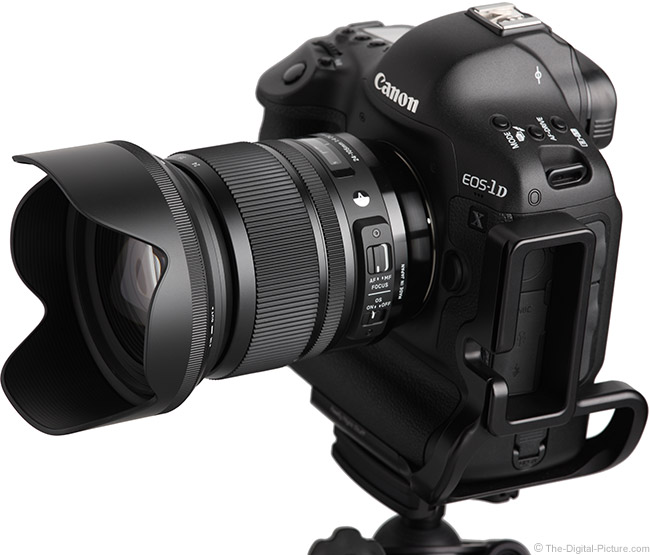
As with all Sigma lenses, the lens hood is included in the box. The rear of this modestly-sized hood has a rubberized surface that, in addition to the molded-in ribbing, makes it easy to grasp for bayonet installation/removal. I seldom take this hood off or even reverse it. Having the hood in set-to-employ position makes using the lens faster to use – which is especially helpful for a lens that I go out on the camera set for quick use around the house or from the bag. My bag for this lens has been the Lowepro Toploader 70 AW. Information technology provides merely the correct amount of room for a DSLR mounted to the 24-105 Bone with the hood in ready-to-use position. I often forgo lens cap use when casing in this way, making the kit even faster to utilise.

Sigma includes their padded, zippered nylon example with this lens. The case is quite protective and a overnice included accessory. A 1.75" (440mm) loop is provided for belt attachment. I personally prefer the Sigma cases to the minimally protective Canon lens pouches.
Sigma recently improved their lens cap design, making them easier to grasp for installation or removal even within the installed hood.
The 82mm filter threads this lens has received are becoming increasingly common. Take note that using a standard thickness round polarizer filter will increase light falloff in frame corners. I highly recommend using a slim model such as the B+Westward XS-Pro.

All Global Vision lenses receive a designation of "A" for Art, "C" for Contemporary or "S" for Sports. As I said before, I honey what Sigma is doing with their lenses right now, merely I'm non yet a fan of potentially limiting the usefulness of a lens to one of these categories. And, I was not sure why this lens received an "A" (vs. a "C" perhaps?). I posed this question to Sigma with the response being "The 24-105 was placed in the Art line because information technology fits the criteria best- large fixed aperture designed for a more creative vision." I'thousand more of the stance that an f/4 discontinuity is medium wide, only it is indeed stock-still. The fantabulous image quality this lens delivers will indeed enhance your artistic expression.
Here is a await at the Sigma 24-105 OS positioned between three other f/4 zoom lenses.
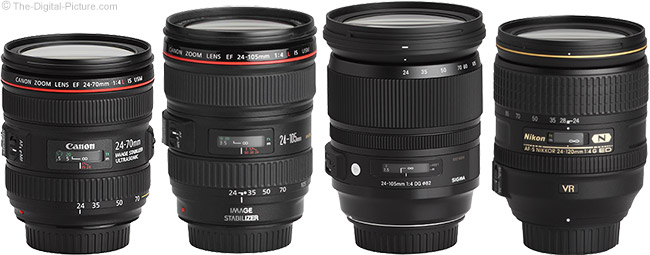
The higher up lenses are, from left to correct, in their fully retracted positions, the following:
Catechism EF 24-70mm f/4 L IS USM Lens
Catechism EF 24-105mm f/4 L IS USM Lens
Sigma 24-105mm f/4.0 DG OS HSM Art Lens
Nikon 24-120mm f/4G AF-South VR Lens
The same lenses are shown below in their fully extended states with their lens hoods in place.

While all of these lenses (and the f/2.8 zooms likewise) tin be compared both optically and physically in the site'south comparison tools, the Canon 24-105 50 IS has been my most-used Canon lens to date. And this is the lens I really wanted to compare to the Sigma.
Compared to the Canon EF 24-105mm f/iv L IS USM Lens
The Sigma enters life with a big challenge on the Canon side of the argue. Canon's focal length range and max aperture equivalent lens has been a long-time favorite that delivers great overall performance at a reasonable cost. The bottom line is that I could be very happy with either of these lenses as my sole full general purpose zoom and that they are more than similar than different.
From a wide open up aperture sharpness perspective, the Sigma performs better in the mid and peripheral areas of the image circle at 24mm through 28mm. The 2 lenses are nearly equivalent from 35mm through 70mm. The Catechism is sharper at 105mm. When using a zoom lens, many of u.s. tend to employ the 2 focal length extremes the most. Sigma wins the 24mm competition and Catechism wins at 105mm.
But that'south at f/4. Cease down to f/5.six, and you lot'll exist hard pressed to discover a difference in sharpness between these lenses.
The Sigma has slightly more than low-cal falloff at long end but shows less flare. The Canon has less pincushion distortion in the mid focal lengths.
The Sigma focuses more than quietly than the Catechism, but the Canon focuses a chip faster than the Sigma. The Canon has a larger and meliorate-positioned focus ring with more rotation (122° vs. 90°). The Canon uses smaller filters (77mm vs. 82mm), only the advantage should become to the size that is already in your kit. The Catechism lens is lighter and slightly smaller – and is weather sealed.
And so, the Sigma presents a strong claiming to this Canon lens. Price is probably going to make the difference to many.
Price
Price, for well-nigh of u.s.a., matters. And the practiced news is that the Sigma 24-105mm f/4.0 DG OS HSM Fine art Lens has a small-scale price tag – especially for what you get. If you lot compare this lens' toll to the toll of the Canon 24-105 Fifty, it looks like a very skillful deal. If you compare the price of this lens to the frequently-been-available white box version of the 24-105 L (a lens pulled from a camera and lens kit), the Sigma'southward price is not such an reward.
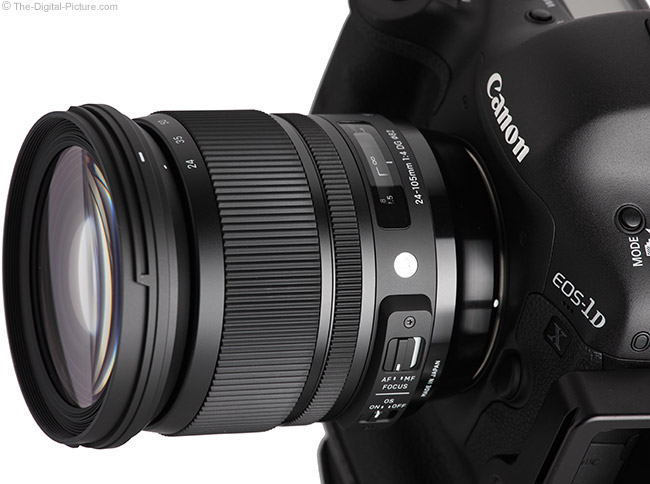
The reviewed Sigma 24-105mm f/4.0 DG Bone HSM Art Lens was loaned to me by Sigma. I usually buy my review lenses online/retail, but Sigma fabricated a product version of this lens bachelor to me earlier this lens striking retailer warehouses. And then I accepted their offer.
The Sigma 24-105mm f/4.0 DG OS HSM Art Lens is available in Canon (reviewed), Nikon and Sony/Minolta. My standard disclaimer: At that place are potential issues with tertiary political party lenses. Since Sigma reverse engineers (vs. licenses) manufacturer AF algorithms, there is always the possibility that a DSLR body might not support a (likely older) third party lens. Sometimes a lens can exist made uniform by the manufacturer, sometimes non. At that place is likewise the run a risk of a trouble that results in the lens and torso manufacturers directing blame at each other. Compatibility with the Sigma USB Dock is gamble reducing equally Sigma tin release firmware updates for the lens. Sigma Usa'south 4-year warranty is superior to Canon's standard 1 yr warranty (Sigma's international warranty is too i twelvemonth).
Worth noting is that, every bit a Global Vision lens, the 24-105 OS qualifies for the Sigma Mountain Conversion service. For a fee, Sigma will convert your 24-105 OS to a unlike manufacturer mount (from Nikon to Canon for example) to protect your investment.

I've tested a lot of lenses that fabricated me broken-hearted to move on. This is not one of them. I would have no problem making this my primary general purpose lens.

The Sigma 24-105mm f/iv.0 DG OS HSM Art Lens' long focal length range will take a broad swath out of your angle of view needs. This great-looking lens is a joy to use and the results from it are even exciting to view. For a reasonable price, the Sigma 24-105mm f/four.0 DG Bone HSM Art Lens reliably delivers the excellent image quality you are looking for from your DSLR camera.
Bringing y'all this site is my full-time chore (typically 60-lxxx hours per week). Thus, I depend solely on the commissions received from yous using the links on this site to make any purchase. I am grateful for your support! - Bryan
My Recommended Sigma 24-105mm f/4.0 DG Os HSM Art Lens Retailers
Rent the Sigma 24-105mm f/4.0 DG Os HSM Art Lens
The Tip Jar
More Sigma 24-105mm f/4.0 DG Bone HSM Art Lens Related Data
Bryan Recommends Buying Information technology Here
Source: https://www.the-digital-picture.com/Reviews/Sigma-24-105mm-f-4.0-DG-OS-HSM-Art-Lens.aspx
0 Response to "Review Sigma 24105mm F4 Dg Os Hsm Art Lens for Nikon"
Enregistrer un commentaire